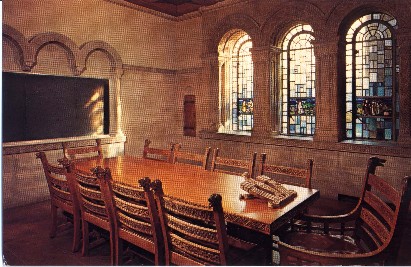
"For the Glary of God and the Honor of Ireland."

The Irish Classroom



A man of genius makes no mistakes. His errors are
volitional and are the portals of discovery.
James Joyce (1882-1941) Irish novelist, poet, playwright
"Ulysses," 1922.
Irish Romanesque architecture, which flourished from the 6th to the 12th centuries, inspired design elements of the Irish Classroom. This limestone room is similar in type, size, and materials to oratories first built on the west coast of Ireland.
Adapted from Killeshin Chapel in County Carlow, the triangular doorway gable is carved with human and animal masks against a background of zig-zag and beaded designs. The blackboard frame's pendental arches are carved with foliage, images of wolfhounds, and stylized cat masks. On the opposite wall a sculptured stone chest, under a monumental recessed arch, is patterned after a bishop's tomb in Cormack chapel. Its ornate sculpture depicts the "Great Beast," a greyhound-like animal wreathed in interlaced ornaments.
On the chest rests a replica of the Gospels from the Book of Kells. The wrought-iron case bears bird and beast designs drawn from the Book of Kells.
Stained-glass windows portray famous teachers at three of Ireland's oldest centers of learning; St. Finnian at Clonard, St. Columkille at Derry, and St. Carthagh at Lismore.
Illuminations in the Book of Kells inspired the chair design, except for the wolfhound heads. The oak-beamed ceiling is characteristic of Irish oratories.
The cornerstone, from the Abbey of Clonmacnoise, is carved with the Gaelic motto, "For the Glory of God and the Honor of Ireland." Behind it is a container with earth from northern and southern Ireland.